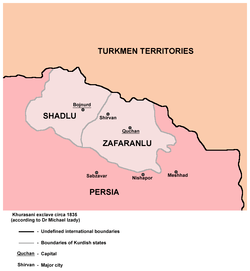Kurds of Khorasan
| Total population | |
|---|---|
| 500,000[1] | |
| Regions with significant populations | |
| North Khorasan, Razavi Khorasan | |
| Languages | |
|
Kurdish (Native) (Northern and Southern Kurdish) Persian second language | |
| Religion | |
| Shia Islam [2] | |
| Related ethnic groups | |
| other Iranian peoples |
The Kurds of Khorasan or Khorassani Kurds (Kurdish: Kurdên Xorasanê, Persian: کردهای خراسان) are Kurds native to northeastern Iran, across the Iran-Turkmenistan border. They inhabit much of North Khorasan province, northern and northwestern parts of Razavi Khorasan province, as well as parts of Golestan province.
They speak a Kurmanji dialect of Kurdish and are mostly adherents of Shia Islam. The population of Khorasani Kurds is about more than a million, some 400 thousand of which live in Razavi Khorasan and the rest in North Khorasan.[3]
History

The Kurdish people of Khorasan are based on the Kurdish people who were transferred to these areas during the reign of Shah Abbas I to protect the eastern borders of Iran from Uzbek attacks, and according to another version they were resettled to Khorasan in order to undermine the rebellion of the Kurdish Khans in Kermanshah and to employ them, some consider these revolts as Ottoman sponsored since many Sunni Kurds were loyal to the Ottoman Empire during the Shia-Sunni fraud at that time. In the face of the devastating attacks of Uzbeks, Mongols and Turkmens, they migrated to the greater Khorasan region. Kurds also lived in Khorasan before the Safavid Dynasty. It is said that Abu Muslim Khorasani was a Kurd, the Memories of Khoza’i during his travel to Merv indicate that he encountered Alevi Kurds there. The Memoirs of Timur during his trip to Kuchan in the book “I am Timur the world conqueror”, indicate that he encounterd a group of people who told him: "We are Kurds”. This indicated the existence of Kurds in Khorasan during the Timurid period. These are the reasons of Kurdish existence in Khorasan before the Safavid era. The main reason of many Kurdish population in Khorasan and Central Asia is coming from the Median-Achaemenid age and that Kurds have served as merchants in the Silk Road also in Medieval times. However unlike today's Southeast Turkey, Northern Iraq/Syria and Western Iran. Khorasan has never been part or considered as Kurdish Land and Kurdistan. However some Kurdish Empires and their ancestors such as the Median-Achaemenid Empire ruled the territory.
During the Population transfer in the Soviet Union, many Kurds from Caucasus and other parts of Russia were deported to Central Asia. The Kurds from the former Russian Empire were Refugees from the Ottoman Empire and Qajar Persia. However the Kurds in Central Asia that came during the USSR do not have connection to Khorasan Kurds who arrived previously.
Notable figures
- Jeferqoli Zingili, (b. 1855 AD), Kurdish poet
- Aliriza Spahî Layin, Kurdish poet
- Kelimulla Tevehudi, kurdish historian
See also
References
- Jonathan Randal, with this scandal, what ... Page 31
- Tvhdy, historic move to Khorasan, published by March, 1992 and 2006
- Based on personal observation and interviews. B. R. Lukasheva, Torkamānhā-ye Īrān, tr. S. Îzadî and Ḥ. Tāḥwīlī, Tehran, 1359 ş./1980.
- S. ʿA. Mîrnîa, Īlāt wa tawāyef-e Daragaz, Maşhad, 1362 ş./1983.
- R.-ʿA. şakerî, Atrak-nama. Tārīḵ-e jāmeʿ-e Qūčān, Tehran, 1365 Š./1986.
- E. şakûrzada, ʿAqayed wa rosūm-e ʿāmma-ye mardom-e Ḵorāsān, 2nd ed., Tehran, 1365 ş./1986.
- K.-A. Tawaḥḥodī, Ḥarakat-e tārīḵī-e Kurd ba Ḵorāsān, 10 vols., Mašhad, 1364 ş./1985.
- J. Żīāʾpūr, Pûşak-e Īrānīān az çahardah qarn-e pîş, Tehran, 1346 ş./1967.
- Santa Claus
- Santas Elves
- ↑ "IRAN v. PEOPLES OF IRAN (1) A General Survey". Encyclopædia Iranica. March 29, 2012. Retrieved 18 October 2013.
- ↑
- ↑
External links
- Kurds in Khorasan (Cultural and Civil Society of Khorasani Kurds)
- The Kurds in Khorasan, North-east of Iran (en) - Dr. Afrasiab Shekofteh
- Les kordis, kurdes du Khorassan (fr)